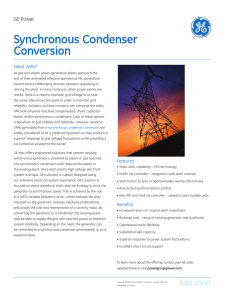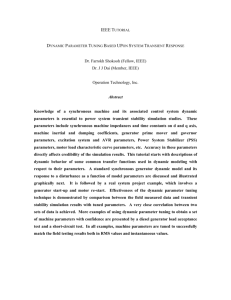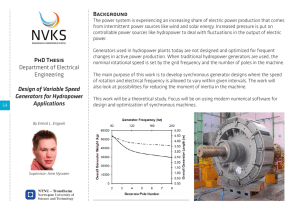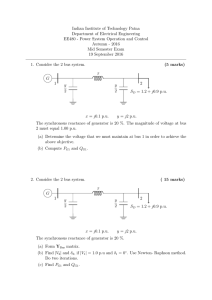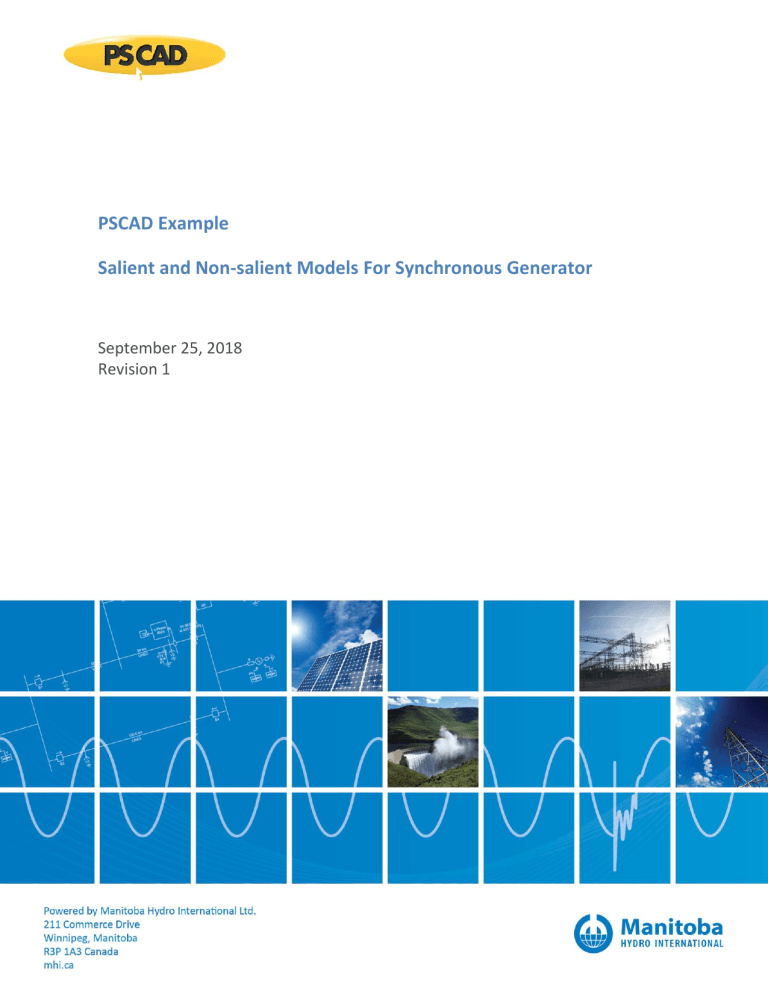
PSCAD Example Salient and Non-salient Models For Synchronous Generator September 25, 2018 Revision 1 PSCAD Example - Salient and Non-salient Models for Synchronous Generator Salient and Non-salient Models for Synchronous Generator Salient pole or non-salient pole synchronous generators can be identified in PSCAD by defining the number of q-axis damper windings. For a salient pole synchronous machine “No. of Q-axis Damper Windings” should be selected as “One”: Figure 1: a salient pole synchronous generator settings Page 1 PSCAD Example - Salient and Non-salient Models for Synchronous Generator For a non-salient pole synchronous machine “No. of Q-axis Damper Windings” should be selected as “two”: Figure 2: a non-salient pole synchronous generator settings The reactance and transient time constants should be selected accordingly: Figure 3: (a) Salient pole (b) non-salient pole synchronous machine typical parameters Page 2 PSCAD Example - Salient and Non-salient Models for Synchronous Generator Case 1: Salient pole synchronous Generator Example This example discusses a salient pole synchronous generator. The Generator connected to; (i) Exciter, (ii) Power system stabilizer, (iii) Multimass, (iv) Hydro Governor and (v) Hydro Turbine. Brief descriptions of all the components are given next. Figure 4: Synchronous machine and the connected power system Page 3 PSCAD Example - Salient and Non-salient Models for Synchronous Generator 1- Exciter A standard IEEE type exciter (i.e AC1A) is selected in this example. Other type of exciters can be selected in the model: Select other type of IEEE standards for exciter All input parameters are either entered in seconds (time constants) or per-unit (all other inputs). The various external inputs and outputs described below: Inputs: Ef0: This input defines the output field voltage to the machine during the initialization period. Ef0 can be either defined by the user or can be defined from within the attached synchronous machine (through a Wire). [VT/IT]: This input is a 3-element array and receives its data from the attached synchronous machine (provided that the machine is set to output this data). VT is the RMS terminal voltage. IT is the synchronous machine terminal current and is complex (i.e. has a real and imaginary component). The real component of IT is in phase with VT and the imaginary component of IT is in quadrature (lagging is positive) with VT. VS: This input is provided only when using the exciter with a power system stabilizer. Vref: This input defines the voltage reference for the synchronous machine terminals. The value can be derived from a number of different components, which might include a slider, a real constant component or some other signal. Page 4 PSCAD Example - Salient and Non-salient Models for Synchronous Generator Outputs: Ef: This output is the computed field voltage applied directly to synchronous machine. A Wire may be used to make the connection. Vref0: This output is the initialized value of the reference voltage Vref and can be applied at the users discretion. More information regarding “Exciter Models” and “Transfer Functions” are available in PSCAD Online help system. 2- Power system Stabilizer A standard IEEE type power system stabilizers (i.e. PSS1A) is selected in this example. Other type of stabilizers can be selected in the model: Figure 5: Select other type of IEEE standards for power stabilizer The inputs to this model are per-unit speed w, synchronous machine terminal voltage Vt and discontinuous controller reference Vk. The output is Vs, which can be speed, terminal frequency, power or none. More information about the Power System Stabilizer Models and their Transfer Functions are available Online in PSCAD help system. Page 5 PSCAD Example - Salient and Non-salient Models for Synchronous Generator 3- Multimass This component simulates the dynamics of up to 26 masses connected to a single rotating shaft. In this example 4 masses are selected as the number of turbines. One mass is normally used to represent the generator, and the electrical torque Te is applied to it. One mass may be used to represent an exciter. The remaining masses represent turbines, and the mechanical torque Tm is divided among them. The resulting speed of the generator Wpu or Wrad is then output, for use as input to the interfaced machine model. Page 6 PSCAD Example - Salient and Non-salient Models for Synchronous Generator 4- Hydro Turbines A standard IEEE type hydro turbine (i.e. Tur1) is selected in this example. Other type of Hydro Turbines can be selected using the parameters “Elastic Water Column” and “Surge Tank” in the model: The inputs to this model are per-unit speed w, per-unit speed reference Wref and gate position z. The outputs are the mechanical torque Tm (which is input to the Synchronous Machine) and initial gate position zi (which is input to the associated Hydro Governor for initialization. For more information regarding the turbine models and transfer functions please refer to online PSCAD help system. Page 7 PSCAD Example - Salient and Non-salient Models for Synchronous Generator 5- Hydro Governor This component can represent one of three IEEE type hydro governor models i.e: GOV1: Mechanical-Hydraulic Controls GOV2: PID Controls including Pilot and Servo Dynamics GOV3: Enhanced Controls for Load Rejection Studies The inputs to this component are per-unit speed w, per-unit speed reference Wref and gate position during initialization z0. The output is the gate position z. More information about the Hydro Governor Models and their Transfer Functions are available Online in PSCAD help system. The dynamics of the system for a three-phase to ground fault is shown in the following figure: Figure 6: Dynamics of salient synchronous generator and the connected power system PSCAD Refer to PSCAD case: SalientGenerator.pscx Page 8 PSCAD Example - Salient and Non-salient Models for Synchronous Generator Case 2: Non-salient pole synchronous Generator Example The dynamics of the non-salient synchronous machine are given in the following figure. As can be seen the dynamics of the synchronous machine takes longer time to damp compare to the silent pole. Figure 7: Dynamics of non-salient synchronous generator and the connected power system PSCAD Refer to PSCAD case: NonsalientGenerator.pscx Page 9 PSCAD Example - Salient and Non-salient Models for Synchronous Generator DOCUMENT TRACKING Rev. Description Date 0 Initial 1/Sep/2016 1 Updated to the new Branding Guidelines 25/Sep/2018 Copyright © 2018 Manitoba Hydro International Ltd. All Rights Reserved. Page 10

